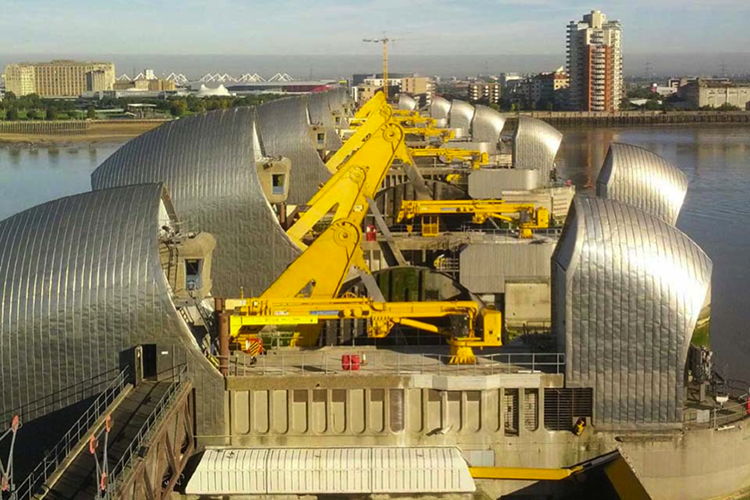Case Study 1: The Thames Barrier
The Thames Barrier spans 520 meters across the River Thames near Woolwich, protecting 125 square kilometers of central London from flooding caused by tidal surges and storms from the North Sea. The barrier became operational in 1982 with 10 steel gates that can be raised into position across the River Thames. When raised, the main gates stand as high as a 5-story building, are as wide as the opening of Tower Bridge, and weigh about 3,300 tons. The barrier is closed under storm surge conditions to protect London from flooding from the sea, but may also be closed during periods of high flow, to reduce the risk of fluvial (river) flooding in some areas of west London including Richmond and Twickenham. The Environment Agency (the agency responsible for the barrier operation) receives information on a potential surge from a variety of sources including weather satellites, oil rigs, weather ships, and coastal stations. At the onset of a predicted surge, the Thames Barrier will close just after low tide, or about 4 hours before the peak of the incoming surge tide reaches the barrier, a process that takes about 1.5 hours for all 10 gates. The Barrier will remain closed until the water level downstream of the Thames Barrier has reduced to the same level as upstream. As of March 2014, the Environment Agency has closed the Thames Barrier 174 times since it became operational in 1982. Of these closures, 87 were to protect against tidal flooding, and 87 were to alleviate river flooding.
Video: How does the Thames barrier protect London from floodings (00:43)
Click for a transcript of the How does the Thames Barrier work? Thames Flood Barrier video.
The Thames barrier was built in 1982 on the River Thames on the eastern side of the capital at Woollett. The barrier made up of ten steel gates has a span of 520 meters across the river. Each gate is 15 meters tall. In an open position, the gates lie flat, allowing the Thames to flow freely and ships to pass through the gates. When the closed position is activated, it takes 75 to 90 minutes for the gates to rotate upwards and create a steel wall that blocks the river in an under-spill position. It allows a controlled amount of water to pass under the gate and up the Thames.

